|
Advantech ARK-DS520
Compact, rugged Intel Atom "Pineview"-based digital signage player with integrated NVIDIA ION2 graphics — an economical solution of signage/kiosk projects
(by Conrad H. Blickenstorfer, photography by Carol Cotton)
The Advantech ARK-DS520 is a very compact (8.66 x 5.9 x 1.75 inches; under four pounds) rugged box computer designed specifically for digital signage applications. Using an efficient single or dual core Intel Atom "Pineview" processor, the DS520 is specially tuned for graphics performance via an integrated NVIDIA ION2 GPU and dedicated DDR3 video memory.
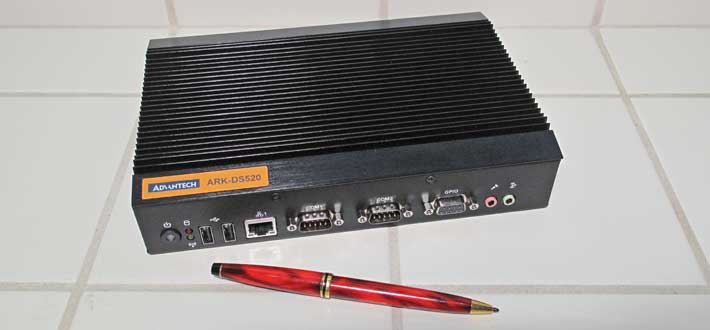
Digital signage players are essentially specialized computers that display customized information in a variety of settings and locations (like airports, arenas, convention centers, hotels, supermarkets, etc.). Since those locations are not always easily accessible they are usually remotely controlled and managed via wired or wireless IP connections. This makes it possible to easily program, schedule and update playlists; remotely monitor player status; and issue remote commands no matter where the player is located.
Unlike conventional computers, digital signage players must be easy to install in places where space and access is limited and operating conditions less than optimal. That is why digital signage players are usually small footprint, low-profile devices that can be installed behind flatscreen displays or even integrated into display housings with special mounting brackets. They must also be quiet, able to handle heat and cold, and reliably run 24/7 with minimal maintenance requirements.
Digital signage content may include a combination of different data (video/Flash, graphics, text and ticker, etc.) in multi-zone layouts, and so digital signage players are designed to provide support for a variety of different media formats. They often use SMIL (Synchronized Multimedia Integration Language), the W3C-defined and recommended XML-based markup language for multimedia presentations.
The ARK-DS520: compact, silent, versatile
The ARK-DS520 is part of Advantech's lineup of "low power" digital signage media players. In this context, the term "low power" doesn't mean low performance; rather, it refers to the power efficiency and cost-effectivess of this class of players, which is usually based on one of Intel's Atom processors.
The images to the right show the Intel Atom N455-powered Advantech ARK-DS520 from the front and back. In terms of I/O, the player provides:
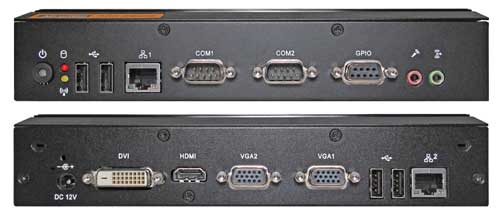
- 4 x USB 2.0 (two front, two back)
- 2 x Serial RS232
- Digital I/O
- Audio Microphone
- Audio Line-Out
- 2 x RJ-45 gigabit LAN
- Power (12 Volt DC)
- HDMI (up to 1080p)
- 2 x VGA Video (up to 2048 x 1536)
- DVI-D Video (up to 1600 x 1200)
As far as physical appearance and construction goes, the housing of the ARK-DS520 measures 8.7 x 5.9 x 1.75 inches and weighs 3.75 pounds. 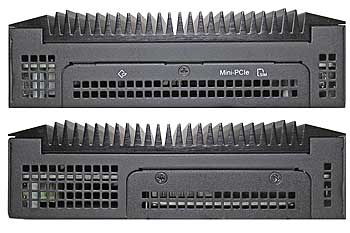 The bottom part is a steel box with ventilation holes on the sides, the top part a heavily finned block of aluminum that acts as a heatsink, eliminating the need for a fan. The bottom part is a steel box with ventilation holes on the sides, the top part a heavily finned block of aluminum that acts as a heatsink, eliminating the need for a fan.
The images to the right show the DS520 from the left and right side, each with an access door. The door panel on one side provides access to the unit's CF Card Type II slot, which is used for systems running off Flash (Advantech sells versions with 4, 8, or 16GB of industrial-grade CF Flash).
The review ARK-DS520 Advantech sent us included a 2.5-inch Seagate Momentus ST9160314AS hard disk with a 3Gb/second SATA interface and a capacity of 160GB. The disk sits in a separate, shock-mounted caddy enclosure underneath the system board. It's spinning at 5,400 RPM and is quite power-efficient, using about 1.4 watts idling and about 1.8 watts operating. The disk's operating temperature range is 32 to 140 degrees Fahrenheit and it can handle operating shocks up to 350Gs. While the DS520 can run off Flash, many signage applications may require the much greater storage space provided by a conventional hard disk.
Below to the right you can see what the DS520 system board looks like from the top and the bottom:
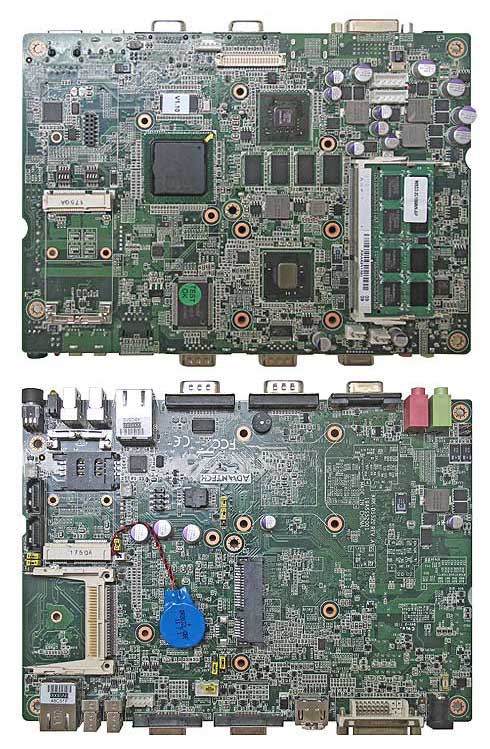 The motherboard itself, essentially an embedded single board computer, measures 8.0 x 5.7 inches and includes the CF Card Type II slot. All I/O connectors are edge-mounted directly on the board, and all other expansion card slots are also directly on the board. The motherboard itself, essentially an embedded single board computer, measures 8.0 x 5.7 inches and includes the CF Card Type II slot. All I/O connectors are edge-mounted directly on the board, and all other expansion card slots are also directly on the board.
On the topside, you can see, moving from left to right, one of the two full-size PCIe slots, the large (31 x 31mm package) Intel ICH8 chip, the small NVIDIA GT218 ION2 chip with its four memory chips, below that the Intel Atom N455 processor, and to the right of that the board's two DDR3 204-pin DIMM slots (populated in our tester by a single 2GB module).
What you don't see is a CPU fan, and that's because the processor, chipset and graphics engine as well as the dedicated onboard display memory and the SODIMM memory module all make contact with the finned aluminum heatsink and dissipate heat that way (a qualification here: systems equipped with the D525 dual-core CPU do have a fan).
On the bottom side of the system board you can see the black edge connector for the hard disk caddy, the white CF Card connector, the second PCI-e slot, which is also full sized, and beneath it a SIM Card slot.
The SIM Card slot wasn't actually listed in the specs, but combined with a WiFi or radio PCIe module, the DS520 obviously can be equipped with wireless data connectivity (or just with WiFi). The PCI-e slots can also be used for adding a TV tuner module or similar extra functionality.
As we've come to expect from the major embedded systems manufacturers, the system board is very clean and totally devoid of any fixes or components that look like they might break off or rattle loose.
NVIDIA ION2 graphics
Advantech's spec sheet describes the ARK-DS520 as an "Advanced (ION2 based) Graphics Digital Signage Platform" and that's because the system's graphics are handled by an integrated NVIDIA GT218 graphic module. As described above, we're not talking discrete graphics on a separate graphics board, but NVIDIA graphics and dedicated video memory on the motherboard itself. With all the emphasis on Intel integrated video these days, why resort to third party graphics?
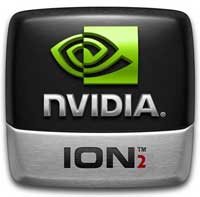 Because the graphics that come with the Atom processor and chipset can't really handle the high graphics demands of a modern digital signage player. Millions of Atom-based netbook users found out they really couldn't run high definition video at an acceptable frame rate. In an earlier Advantech digital signage player we reviewed, the ARK-DS303, Advantech handled the problem with an optional PCIe Broadcom "Crystal HD" hardware accelerator module using the Broadcom AVC/MPEG-2/VC-1 video/audio BCM70010/BCM70012 decoder chipset. With the DS520, they went a different route and chose a fully integrated third party graphics solution with the ION2. Because the graphics that come with the Atom processor and chipset can't really handle the high graphics demands of a modern digital signage player. Millions of Atom-based netbook users found out they really couldn't run high definition video at an acceptable frame rate. In an earlier Advantech digital signage player we reviewed, the ARK-DS303, Advantech handled the problem with an optional PCIe Broadcom "Crystal HD" hardware accelerator module using the Broadcom AVC/MPEG-2/VC-1 video/audio BCM70010/BCM70012 decoder chipset. With the DS520, they went a different route and chose a fully integrated third party graphics solution with the ION2.
The purpose of NVIDIA ION2 graphics is to provide much better graphics performance for advanced applications than the standard processor-integrated graphics can. In consumer notebooks that meant the ability to play complex games, in netbooks being able to watch full 1080p HD video, and in digital signage the ability to power multiple video streams at acceptable speed. ION2 refers to the second generation of the ION platform which, in contrast to the first generation, is just a GPU and not an entire chipset. As such, it works in conjunction with the Intel Atom "Pine Trail" platform used in the ARK-DS520 (as well as in millions of second and third gen netbooks). See NVIDIA's ION page with a demo video here.
In its documentation, Advantech claims over 10 times normal performance in media playback with the ION2 and NVIDIA Optimus technology.
To see how the ION2-based ARK-DS520 compares to the value-positioned ARK-DS303 with the Broadcomm module we ran our standard PassMark and CrystalMark benchmark suites. To illustrate how these devices with their tweaked graphics compare with Atom boards running standard Intel graphics, we included the test results of the Advantech SOM-6760 and SOM-5761 (see comparison here), two COM-Express boards running first-gen Atom chips. The results are as follows:
|
BENCHMARK PERFORMANCE
|
ARK-DS520
|
ARK-DS303
|
SOM-6760
|
SOM-5761
|
|
Device Type
|
Signage Player
|
Signage Player
|
COM-Micro
|
COM-Express
|
|
Processor
|
1.66GHz Atom N455
|
1.6GHz Atom N270
|
1.6GHz Atom Z530
|
1.6GHz Atom N270
|
|
TDP
|
6.5 watts
|
2.5 watts
|
2.3 watts
|
2.5 watts
|
|
Graphics
|
NVIDIA ION2
|
Broadcomm
|
Intel
|
Intel
|
|
CPU Mark
|
248.7
|
252.6
|
315.6
|
321.1
|
|
2D Graphics Mark
|
71.3
|
158.7
|
207.2
|
192.5
|
|
Memory Mark
|
220.4
|
227.7
|
191.6
|
199.1
|
|
Disk Mark
|
445.9
|
459.4
|
70.7
|
74.6
|
|
3D Graphics Mark
|
169.1
|
77.3
|
19.6
|
71.5
|
|
Overall PassMark
|
226.3
|
232.6
|
137.3
|
190.7
|
|
CPU Alu
|
6,296
|
5,409
|
5,376
|
5,413
|
|
CPU FPU
|
4,033
|
4,671
|
4,667
|
4,726
|
|
Memory
|
6,033
|
4,223
|
3,667
|
4,172
|
|
HDD
|
7,827
|
8,221
|
2,702
|
2,676
|
|
GDI
|
2,302
|
2,158
|
2,427
|
2,239
|
|
D2D (Sprites)
|
2,936
|
2,230
|
1,009
|
2,180
|
|
OpenGL
|
5,183
|
684
|
505
|
704
|
|
Overall CrystalMark 2004R2
|
34,610
|
27,596
|
20,353
|
22,110
|
|
Playback 1280x720 (720p) HD movie in QuickTime
|
Flawless
|
Flawless
|
4-5 fps (choppy)
|
8-10 fps (choppy)
|
As is usually the case with benchmarks, the results are both interesting and a bit confusing. For example, the original Z5xx Series of Atom processors always benchmarked poorly in 3D tasks, though their subjective performance seemed no worse than that of the N2xx Series used in netbooks.
As far as the DS520 goes, the CrystalMark showed very good 2D performance and the PassMark 3D performance score is excellent. The PassMark 2D graphics score is unexpectedly low even compared to a standard N270 board, though subjectively the DS520 performed at least at the N270 level. Where the ION2 implementation really shines is in OpenGL, the cross-platform API widely used in complex information visualization, simulations and games. In the CrystalMark OpenGL benchmark, the DS520 easily outperformed even Intel Core I5/i7-based systems. Nothing without discrete graphics comes even close.
We didn't have a benchmark for HD encoding and decoding, but subjectively, the DS520 (like the DS303) provided flawless 720p and 1080p playback, something older Z530 and N270-based systems definitely couldn't.
Dual-screen support and applications
The Advantech ARK-DS520 has no fewer than four ways to connect to a graphics display. There are two standard VGA ports, a DVI-D digital visual interface connector, and also an HDMI port. The device supports two displays at the same time, in whatever mix of ports that is required (there are six possible permutations). There are numerous possible configurations for signage, kiosk and other applications. You could, for example, have a super-high res 4096 x 1536 pixel application running on two standard displays connected to the two VGA ports. You could run 1080p video through HDMI and use a second display for supplementary information. Depending on the application software used, there are all sorts of display spanning and cloning possibilities.
For display settings and configurations, the ARK-DS520 comes with a special NVIDIA control panel that provides precise control over each attached display (see below).
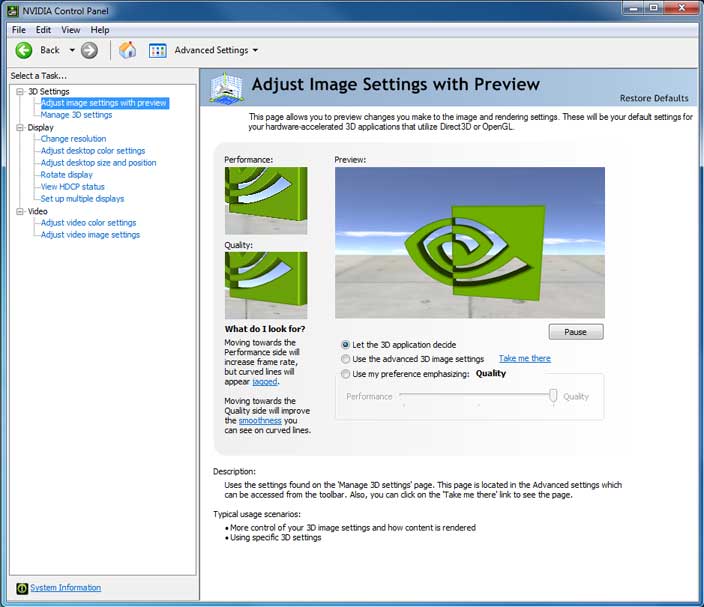
Note that Advantech also offers a TV tuner module so that TV programing can be included when real-time news or entertainment is crucial. CEC (Consumer Electronics Control) is implemented on HDMI and that can potentially be used to control up to ten CEC-enabled devices.
Ruggedness and utilities
In terms of ruggedness, the requirements for a digital signage player are different than those of a mobile computer. The housing is tough and very sturdy, and designed to handle the kind of shocks and vibration that may be encountered by fixed-mount system. It is not sealed though.
Unlike consumer-grade, off-the-shelf media players, the Advantech ARK-DS520 is expected to run 24/7 all the time, with minimal maintenance requirements. That's why it is not only built like a tank, but also comes with special BIOS settings for digital signage applications, such as system Wake-on-LAN and Power-On-after-Power-Failure settings. There is also an embedded watchdog timer that allows for near 100% uptime, and there are additional functions that help the system recover from fatal errors or system crashes.
The system also includes a number of special Advantech utilities:
- The Advantech Booting Manager lets developers turn off a variety of Windows-specific logos and screens. So instead of booting up like a standard PC, a digital signage may simply boot directly into its custom software, without any Windows logo, logins, sounds, and so on.
- The Enhanced Write Filter, or EWF, is a security feature that lets you write-protect a run-time image by redirecting write operations to another storage location, thus preventing any damage that might be caused by an unexpected power failure, vibration or even a virus attack.
- FBWF, the "File Based Write Filter," lets embedded systems developers quickly prototype and integrate file-based write filters. FBWF is used to provide the appearance of read and write access to write-sensitive or read-only storage and makes read and write access transparent to applications. What FBWF does is write to a cache instead of media that is not supposed to be altered or written on. As such, FBWF acts a bit like EWF, but it's more powerful and there are more features.
Bottom line
The Advantech ARK-DS520 Digital Signage Platform is a remarkably compact industrial PC that combines low power efficiency of Intel "Pine Trail" Atom processors with powerful NVIDIA ION2 discrete, but integrated, graphics. The device supports two separate displays connected in six different ways to four different output ports. The NVIDIA ION2 GPU provides considerably stronger graphics performance, resulting in flawless HD video playback. The system is also capable of stellar OGL performance.
Designed and manufactured as an industrial-class device, the DS520 is for digital signage/kiosk projects where requirements include maximum life expectancy even under 24/7 operation, the ability to handle wide temperature ranges, a long product life cycle, and, thanks to the NVIDIA ION2 GPU, the ability to play high definition content on a low cost, low power Atom-based device. In our review and testing, the light and compact ARK-DS520 convinced with extremely solid construction and very good performance.
Customers will have to decide between the fanless single-core Intel Atom N455 version (US$730) and the only slightly more expensive dual-core Intel Atom D525 version (US$750) that does have a fan.
-- Conrad H. Blickenstorfer, May 2012
Advantech ARK-DS520 Digital Signage Player Specs:
| Added/updated |
Added May 2012
|
| Type |
Rugged digital signage IPC
|
| CPU Type |
Single-core 1.66GHz Intel Atom N455 or dual-core 1.8GHz Atom D525
|
| Chipset |
Intel ICH8M
|
| CPU Thermal Design Power |
N455: 6.5 watts; D525: 13 watts |
| L2 cache |
N455: 512 KB; D525: 1 MB |
| Front Side Bus |
800/667MHz |
| OS |
Windows 7, Windows XP Embedded, Windows XP, Windows Embedded Standard, Windows Embedded Standard 7, Linux
|
| Memory |
N455: max. 2GB; D525: max. 4GB in two DDR3 204-pin DIMM |
| Graphics Controller |
NVIDIA GT218 w/ dedicatd 512MB DDR3
VGA: up to 2048 x 1536 pixel
DVI-D: up to 1600 x 1200
HDMI: up to 1080p |
| Hardware HD decoder |
via NVIDIA GT218 ION2 technology
|
| LAN |
RJ45 10/100/1000 Base-T (Intel 82567V)
RJ45 10/100/1000 Base-T (Realtek RTL81111D-GR)
|
| SATA |
Internal 160GB 5,400 RPM 2.5-inch Seagate SATA/300 drive |
| Expansion slots |
1 x Compact flash type I/II slot, 2 x PCIe, 1 SIM
|
| Housing |
Aluminum/steel; desktop/wallmount
|
| Vibration |
0.3 Grms, IEC 60068-2-64, random, 5 ~ 500 Hz, 1 Oct./min, 1 hr./axis.
|
| Shock |
20 G, IEC 60068-2-27, half sine, 11 ms duration
|
| EMC |
CE, FCC
|
| Certifications |
UL, CB, CCC, BSMI
|
| Operating Temp. |
32 - 104F operating |
| Humidity |
95% @ 104F (non-condensing), operating |
| USB |
4 x USB 2.0
|
| Serial |
2 x RS232 + 1 x GPIO (D-Sub 15-pin) |
| Video |
1 x HDMI, 2 x VGA, 1 x DVI-D (supports dual independent display)
|
| Watchdog Timer |
255-level timer, software setup
|
| Audio |
LIne Out, Line In, Mic. |
| Size |
8.66 x 5.9 x 1.75 inches (220 x 150 x 44 mm)
|
| Weight |
3.75 lbs. (1.7kg) |
| Power |
12 VDC (ATX/AT mode)
|
| User manual |
ARK-DS520 User Manual (PDF)
|
| Product page |
ARK-DS520 spec page (PDF)
|
| Price |
Base price: US$730 (see DS520 at Advantech store) |
Advantech Corporation
38 Tesla, Suite 100
Irvine, CA 92618
Toll Free: 1-800-866-6008
Ph: 949-789-7178
Fax: 949-789-7179
ECGInfo@advantech.com
www.advantech.com
Advantech Co. Ltd.
No.1, Alley 20, Lane 26, Rueiguang Road
Neihu District, Taipei Taiwan 114, R.O.C.
Tel: 886-2-2792-7818
Fax: 886-2-2794-7301
www.advantech.com
|



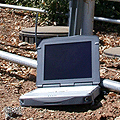

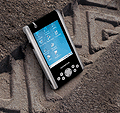
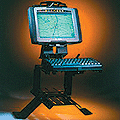







 The bottom part is a steel box with ventilation holes on the sides, the top part a heavily finned block of aluminum that acts as a heatsink, eliminating the need for a fan.
The bottom part is a steel box with ventilation holes on the sides, the top part a heavily finned block of aluminum that acts as a heatsink, eliminating the need for a fan.
 The motherboard itself, essentially an embedded single board computer, measures 8.0 x 5.7 inches and includes the CF Card Type II slot. All I/O connectors are edge-mounted directly on the board, and all other expansion card slots are also directly on the board.
The motherboard itself, essentially an embedded single board computer, measures 8.0 x 5.7 inches and includes the CF Card Type II slot. All I/O connectors are edge-mounted directly on the board, and all other expansion card slots are also directly on the board.
 Because the graphics that come with the Atom processor and chipset can't really handle the high graphics demands of a modern digital signage player. Millions of Atom-based netbook users found out they really couldn't run high definition video at an acceptable frame rate. In an earlier Advantech digital signage player we reviewed, the ARK-DS303, Advantech handled the problem with an optional PCIe Broadcom "Crystal HD" hardware accelerator module using the Broadcom AVC/MPEG-2/VC-1 video/audio BCM70010/BCM70012 decoder chipset. With the DS520, they went a different route and chose a fully integrated third party graphics solution with the ION2.
Because the graphics that come with the Atom processor and chipset can't really handle the high graphics demands of a modern digital signage player. Millions of Atom-based netbook users found out they really couldn't run high definition video at an acceptable frame rate. In an earlier Advantech digital signage player we reviewed, the ARK-DS303, Advantech handled the problem with an optional PCIe Broadcom "Crystal HD" hardware accelerator module using the Broadcom AVC/MPEG-2/VC-1 video/audio BCM70010/BCM70012 decoder chipset. With the DS520, they went a different route and chose a fully integrated third party graphics solution with the ION2.
